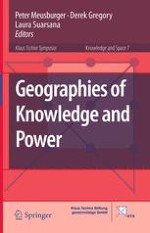2015 | OriginalPaper | Chapter
10. Knowledge and Power in Sovietized Hungarian Geography
Authors : Róbert Győri, Ferenc Gyuris
Published in: Geographies of Knowledge and Power
Publisher: Springer Netherlands
Activate our intelligent search to find suitable subject content or patents.
Select sections of text to find matching patents with Artificial Intelligence. powered by
Select sections of text to find additional relevant content using AI-assisted search. powered by
